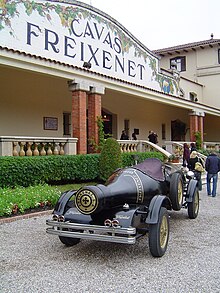Freixenet
| Freixenet
|
|
|---|---|
| legal form | Sociedad Anónima (SA) |
| founding | 1914 |
| Seat | Sant Sadurní d'Anoia , Spain |
| Branch | Wine & Cava |
| Website | www.freixenet.es |
Freixenet [ ˌfɾəʃə'nɛt ], German [ ˌfʁɛʃə'nɛt ] is a trading company for cava and wine with headquarters in Sant Sadurní d'Anoia , a city west of Barcelona ( Catalonia ) in Spain . Freixenet is one of the best-known and largest cava producers in Spain and has been majority owned by the Henkell & Co. Sektkellerei Group from Wiesbaden since March 2018 .
history
Freixenet was founded by the merger of two Spanish families who already had a long tradition in wine production: on the one hand the Ferrers , owners of La Freixeneda , a country estate from the 12th century in Sant Quintí de Mediona in the Alt Penedès , and on the other hand the Salas , Winemaker since 1830 and founder of Casa Sala in Sant Sadurní d'Anoia , a wine exporter to Latin America.
The name Freixenet arose from the fact that the winery was surrounded by groves full of ash trees ( Catalan freixe ). The owner Pedro Ferrer Bosch was therefore called El Freixenet by the local population .
Towards the end of the 19th century, Dolores Sala Vivé, the granddaughter of the founder of the Casa Sala, married Pedro Ferrer Bosch from La Freixeneda. At that time Spain had to watch the gradual loss of its colonies and the loss of grapes due to the Phylloxera plague, which had destroyed many vines in Europe. Encouraged by the success of Champagne , Codorníu and others encouraged the vineyard owners to increasingly use white grapes such as Macabeo , Parellada and Xarel lo for sparkling wine production. These grapes are still the primary grapes of the cava today, although some producers are experimenting with the use of the Champagne grapes of Chardonnay and Pinot Noir .
As a result, the newlyweds joined forces with Dolores' father to form the family business Sala, to produce sparkling wines using both traditional and champenoise methods.
Freixenet has been producing its leading product, the Cava Carta Nevada , since 1941 and the Cava Cordon Negro since 1974 . About 95% of Spain's total cava production comes from the Catalan village of Sant Sadurní d'Anoia.
In March 2018, the Henkell Group took over 50.67 percent of the shares and thus became the majority owner.
Casa Freixenet
The Casa Freixenet, which today consists of five halls, was designed by the modernist architect Josep Ros i Ros and completed in 1927. The central main building was opened in 1929; the visitor center is located here today. The facade was decorated with paintings and colors typical of the Noucentisme period .
Brands
Freixenet represents Cava Carta, Cordon, Elyssia and Reserva Real as well as the wines Mederaño, Mia, Legero and Solar Gran Rioja Crianza.
In addition to Freixenet , the company also markets a number of other brands:
- Segura Viudas
- René Barbier
- Castellblanch
- Canals & Nubiola
- Conde de Caralt
- Vionta
- Morlanda
- Valdubón
- Henri Abelé
- Gloria Ferrer
- Sala Vivé
- Wingara Wine Group
- Yvon Mau
- Fra Guerau
- Viento Sur
- Arerunguá
- Solar Viejo
- Oroya (sushi wine)
- Terra Nova
Locations
Spanish regional headquarters
- Sant Sadurní d'Anoia , Catalonia
- Laguardia Álava , Basque Country
- A Coruña , Galicia
- Las Palmas , Gran Canaria , Canaries
- Madrid
- Santander
- Seville
International seats
- Wiesbaden , Germany
- New York , NY, United States
- Sonoma , CA, United States
- Crowthorne , Berkshire , United Kingdom
Awards
Reserva Real
- 2005 bronze medal The International Wine and Spirit Competition 2005 , London
- 2007 gold medal Vinordic Wine Challenge 2007 , Stockholm
- 2008 Silver Medal VIII Conculusio Internacional de Vinos Bacchus 2008
Cuvée DS 2001
- 2006 bronze medal The International Wine and Spirit Competition 2006 , London
Cuvée DS 2002
- 2007 silver medal International Wine & Spirit Competition 2007 , London
- 2007 bronze medal Challenge International du Vin 2007 , Bordeaux
Brut Nature 2003
- 2007 bronze medal International Wine & Spirit Competition 2007 , London
Individual evidence
- ↑ A Spanish export hit becomes German. In: Hannoversche Allgemeine . March 16, 2018, accessed March 17, 2018 .
- ↑ Tobias Pehle, Ulrike Erlacher: Dumonts Kleines Lexikon Champagner, Sekt & Co. Dörfler Verlag, Eggolsheim 2008, ISBN 978-3-89555-535-0 , p. 172.
- ^ Thomas Urban : Freixenet becomes German. In: sz.de , March 18, 2018.
swell
- www.freixenet.es (Spanish) (also in English and Catalan )
- www.freixenet.de
Coordinates: 41 ° 25 ′ 12.6 " N , 1 ° 47 ′ 31.8" E


